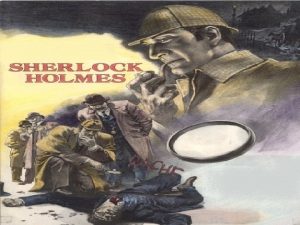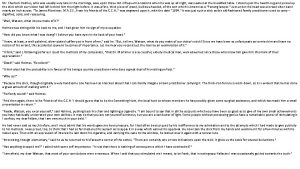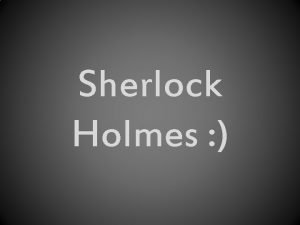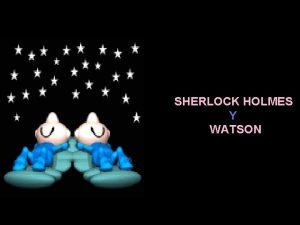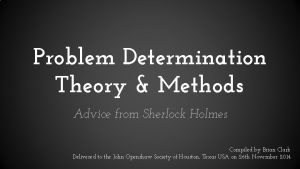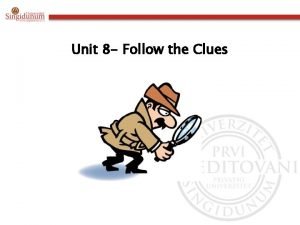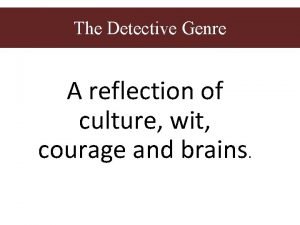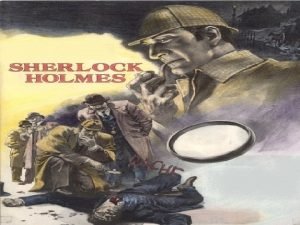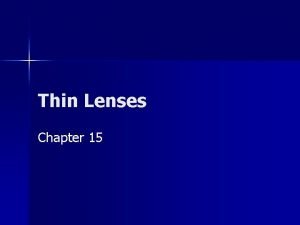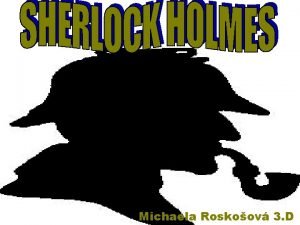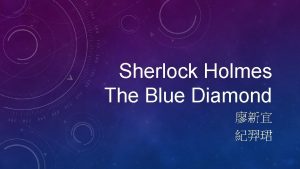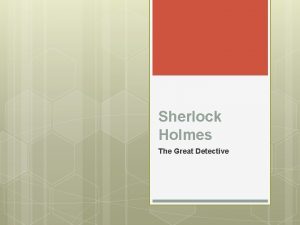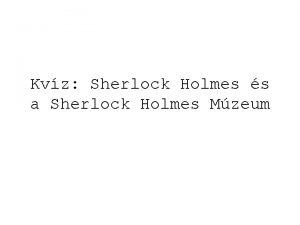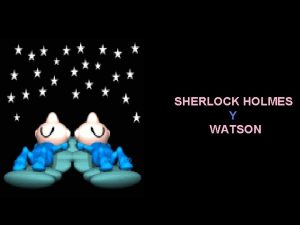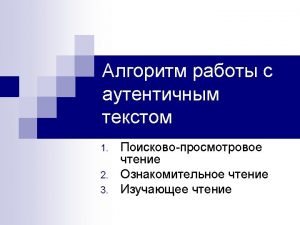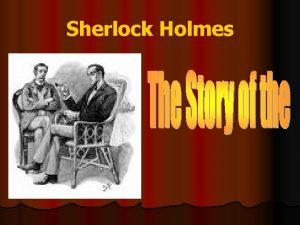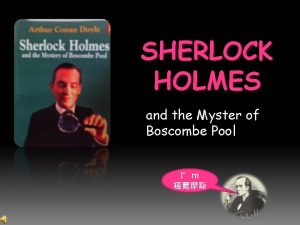Who is Sherlock Holmes Sherlock Holmes Most people













- Slides: 13

Who is Sherlock Holmes?

Sherlock Holmes “Most people think of Holmes as a force of pure reasoning, an almost superhuman mind capable of solving any puzzle. ” “Sherlock Holmes’s keen observations and ability to reason allow him to solve puzzles that puzzle everyone else. ” “Sometimes quiet and contemplative, other times bursting with energy, Holmes uses methodology that can confuse and frustrate others. ” “He is somewhat of a mystery, rarely divulging his thoughts until he’s already solved the crime. ”

Detective Stories • C. Hugh Holman’s A Handbook to Literature defines a detective story as “a novel or short story in which a crime, usually a murder – the identity of the perpetrator unknown – is solved by a detective through a logical assembling and interpretation of palpable evidence, known as clues. ” • The first detective stories were written by Edgar Allan Poe, and Conan Doyle acknowledged their influence on his writing.

“Rules” of Detective Stories 1. The crime must be significant. 2. The detective must be memorable. 3. The criminal must be a worthy opponent. 4. The clues must be made available to the reader. 5. The suspects must appear early in the story. 6. The solution must be reasonable and possible.

A Study in Scarlet • The first in four full-length Sherlock Holmes novels, and the first to introduce Sherlock Holmes and John Watson. • First published in 1887 in the Beeton’s Christmas Annual magazine, of which only 11 copies remain. • Published as a book in 1888. • The first detective story to feature a detective using a magnifying glass. • Reveals that all of the Sherlock Holmes stories are ”[a] Reprint from the Reminiscences of John H. Watson, MD, Late of the Army Medical Department. "

Q 1 List four architectural features of the hospital. As he spoke, we turned down a narrow lane and passed through a small side-door, which opened into a wing of the great hospital. It was familiar ground to me, and I needed no guiding as we ascended the bleak stone staircase and made our way down the long corridor with its vista of whitewashed wall and dun-coloured doors. Near the further end a low arched passage branched away from it and led to the chemical laboratory.

How does Doyle use structure to interest the reader? "Ha! ha!" he cried, clapping his hands, and looking as delighted as a child with a new toy. "What do you think of that? " "It seems to be a very delicate test, " I remarked. "Beautiful! beautiful! The old Guiacum test was very clumsy and uncertain. So is the microscopic examination for blood corpuscles. The latter is valueless if the stains are a few hours old. Now, this appears to act as well whether the blood is old or new. Had this test been invented, there are hundreds of men now walking the earth who would long ago have paid the penalty of their crimes. ” "Indeed!" I murmured. "Criminal cases are continually hinging upon that one point. A man is suspected of a crime months perhaps after it has been committed. His linen or clothes are examined, and brownish stains discovered upon them. Are they blood stains, or mud stains, or rust stains, or fruit stains, or what are they? That is a question which has puzzled many an expert, and why? Because there was no reliable test. Now we have the Sherlock Holmes' test, and there will no longer be any difficulty. " His eyes fairly glittered as he spoke, and he put his hand over his heart and bowed as if to some applauding crowd conjured up by his imagination. "You are to be congratulated, " I remarked, considerably surprised at his enthusiasm. Q 2

How does Doyle use structure to interest the reader? "Ha! ha!" he cried, clapping his hands, and looking as delighted as a child with a new toy. "What do you think of that? " "It seems to be a very delicate test, " I remarked. "Beautiful! beautiful! The old Guiacum test was very clumsy and uncertain. So is the microscopic examination for blood corpuscles. The latter is valueless if the stains are a few hours old. Now, this appears to act as well whether the blood is old or new. Had this test been invented, there are hundreds of men now walking the earth who would long ago have paid the penalty of their crimes. ” "Indeed!" I murmured. "Criminal cases are continually hinging upon that one point. A man is suspected of a crime months perhaps after it has been committed. His linen or clothes are examined, and brownish stains discovered upon them. Are they blood stains, or mud stains, or rust stains, or fruit stains, or what are they? That is a question which has puzzled many an expert, and why? Because there was no reliable test. Now we have the Sherlock Holmes' test, and there will no longer be any difficulty. " His eyes fairly glittered as he spoke, and he put his hand over his heart and bowed as if to some applauding crowd conjured up by his imagination. "You are to be congratulated, " I remarked, considerably surprised at his enthusiasm. Q 3

Based on the whole chapter, how far would you agree that “Doyle’s writing presents Sherlock’s character as its main mystery. ” • • Johns: Page 2 Pauls: Page 3 • Georges: Page 4 • Ringos: Page 5 • Yokos: Page 6 In groups, note down every mention or description of Sherlock that could: Present him as a mystery Create intrigue around his character Make a vague statement about him Q 4

Question 4: Critical Evaluation Level Skills Descriptor • Evaluates critically and in detail the effect(s) on 4 the reader • Shows perceptive understanding of writer’s Perceptive, methods detailed • Selects a judicious range of textual detail 16 -20 marks • Develops a convincing and critical response to the focus of the statement 3 Clear, relevant 11 -15 marks • • Evaluates clearly the effect(s) on the reader Shows clear understanding of writer’s methods Selects a range of relevant textual references Makes a clear and relevant response to the focus of the statement

Victorian London • What inventions were introduced in the Victorian Era? How would they have affected London? • How did the British Empire influence the Sherlock Holmes stories? What effect might it have had on the readers? • What is empiricism, and what was Darwin’s connection to it? • What was Sherlock’s relevance to science and empiricism? • How did the social classes in Victorian London increase Doyle’s popularity?

Inspiration behind Sherlock Holmes • What was Doyle’s problem with detective stories? How did he solve it with his stories? • How did Dr. Joseph Bell inspire the character of Sherlock Holmes? • How were the Sherlock Holmes stories originally published? Did it help or hurt their popularity? • How did the popularity of the character save Sherlock from death?

Characterisation of Sherlock Holmes Based on the article, list all of Sherlock’s characteristics and attribute:
 Sherlock holmes first appearance
Sherlock holmes first appearance Sherlock holmes database
Sherlock holmes database Mr sherlock holmes who was usually very late
Mr sherlock holmes who was usually very late Sherlock účinkujúci
Sherlock účinkujúci Chiste de sherlock holmes y watson
Chiste de sherlock holmes y watson Sherlock holmes a scandal in bohemia summary
Sherlock holmes a scandal in bohemia summary Sherlock holmes when you have eliminated the impossible
Sherlock holmes when you have eliminated the impossible Sherlock holmes looking for clues
Sherlock holmes looking for clues Detective genre definition
Detective genre definition Fictional character
Fictional character Sherlock holmes examines a clue by holding his
Sherlock holmes examines a clue by holding his Pomocnik holmesa
Pomocnik holmesa The blue diamond sherlock holmes
The blue diamond sherlock holmes Sherlock holmes reality
Sherlock holmes reality
